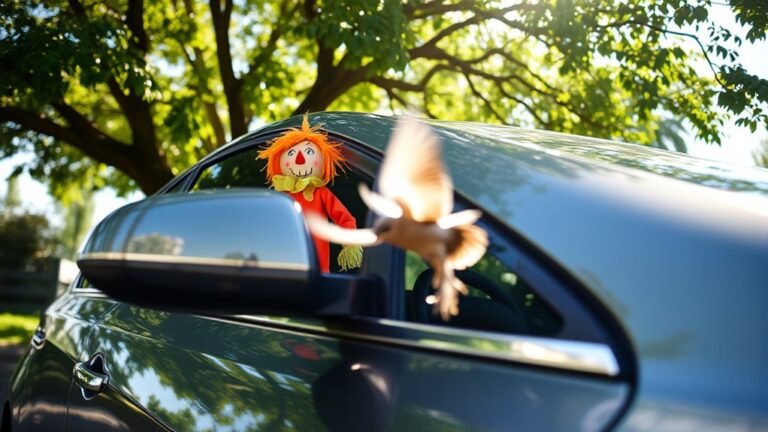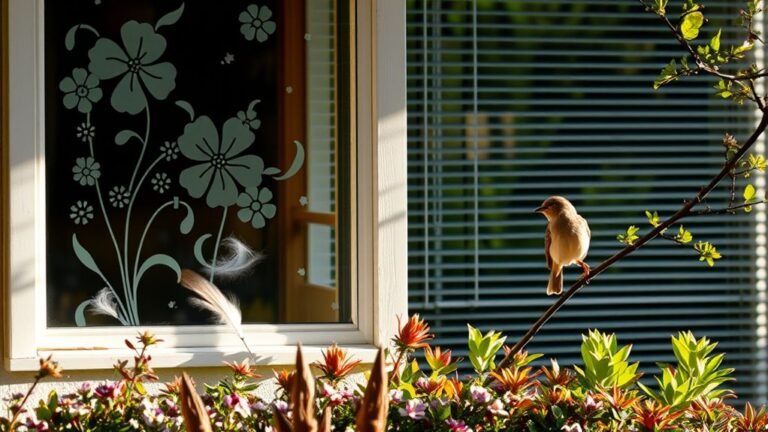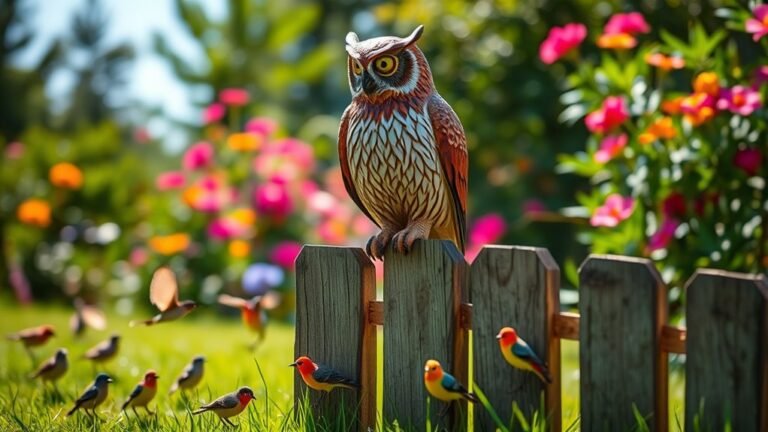How to Stop Birds From Hitting Windows
Birds often hit windows because they see reflections or transparency. This creates safety concerns for them. To reduce these collisions, it is important to understand how birds behave and to recognize which windows are most at risk. There are several ways to decrease these incidents, such as adding visual markers or installing physical barriers. Choosing the best methods involves looking closely at your surroundings. By combining different strategies, you can significantly help protect bird populations.
Key Takeaways
- Install window treatments like sheer curtains or blinds to reduce transparency and prevent bird collisions.
- Place reflective stickers or decals on windows in groups and at varying heights to disrupt reflections that confuse birds.
- Use physical barriers such as window screens or netting to create an obstacle against potential collisions.
- Monitor bird collisions in your area to identify high-risk windows and evaluate the effectiveness of your prevention methods.
- Educate the community on bird safety through workshops, flyers, and social media to promote awareness and collective action.
Understanding Bird Behavior

Birds often collide with windows because they mistakenly see reflections, such as trees or sky, as open space. When your window reflects these elements, birds may think they can fly through it. Their fast, agile flight patterns increase the chance of crashes.
Many birds rely on their vision for navigation, which makes them susceptible to hitting barriers they can't see. To prevent these accidents, you can use window decals or external screens.
These measures create a safer environment for birds and strengthen your bond with nature.
Common Window Types at Risk
Certain window types can lead to bird collisions. Large glass areas without visual markers confuse birds.
Here are window types that are risky for birds:
- Floor-to-ceiling windows
- Skylights
- Glass doors
- Bay windows
- Windows without screens
These designs can create reflections or transparency that mislead birds.
Windows facing open spaces or gardens can further attract birds, increasing the chances of collisions.
By knowing which window types pose risks, you can take steps to protect birds. Simple changes in your home can help create a safer environment for these creatures.
Making adjustments can help local bird populations thrive while enhancing your living space.
The Importance of Window Treatments

Window treatments are important for protecting birds from colliding with glass surfaces. They create visual markers that make windows more visible.
Options like sheer curtains or blinds reduce transparency, signaling to birds that there's a barrier. Choosing stylish window treatments can enhance your home's decor while serving this protective function.
Patterns or colors that contrast with nature can improve visibility even more. By considering these designs, you help protect wildlife and contribute to a community that values nature.
Investing in the right window treatments is an easy and effective solution for homeowners.
Applying Stickers and Decals
To stop birds from flying into windows, use stickers and decals. These markers break the reflection that confuses birds. Choose designs that are visible, especially in bright sunlight.
For the best effect, follow these tips for sticker placement:
- Group stickers in certain areas.
- Choose colors that contrast for better visibility.
- Keep stickers no more than 4 inches apart.
- Place stickers at different heights to suit various bird species.
- Use reflective or patterned designs that resemble natural obstacles.
This method can help keep birds safe while adding a visual element to your windows.
Using Window Screens and Netting

Installing window screens and netting can reduce bird collisions with glass surfaces. These barriers serve as a physical deterrent.
Window screens are made from strong materials that allow light to pass through while blocking birds' paths. Mesh netting, specifically for bird protection, can be placed outside windows to create a buffer zone. When positioned correctly, these barriers help birds see solid surfaces and lower the risk of impact.
Using window screens and netting makes your home safer for birds and enhances conservation efforts. This simple upgrade supports wildlife protection and fosters community awareness.
Installing Bird-Friendly Glass
Choosing bird-friendly glass for your windows can reduce bird collisions. This material has patterns that help birds see the glass as an obstacle.
Here are the benefits to consider:
- Increased visibility: The patterns help birds easily see the glass.
- Variety of options: You can find bird-safe films and panels for different home styles.
- Energy efficiency: Many bird-friendly glasses can also insulate your home.
- Aesthetic appeal: Designs can enhance your home's look while keeping safety in mind.
- Environmental impact: Protecting birds helps conserve biodiversity.
Bird-friendly glass provides practical solutions while contributing to a better environment.
Creating Visual Barriers
Creating visual barriers helps stop birds from hitting windows. You can use materials like decals, window films, or light curtains to block the bird's view.
Adding patterns or shapes can make these barriers even better. Birds see these features as obstacles, which helps them avoid the windows.
Choose materials that are strong and fit your area. By using these methods, you protect birds and beautify your home.
Talking to your neighbors about this topic can build a community focus on wildlife conservation, making your efforts even more effective.
Strategically Placing Outdoor Feeders
Birds look for food sources close to your home. The way you place outdoor feeders can change their flight paths and help prevent them from hitting windows.
Smart feeder placement attracts many bird species and keeps them safe. Here are some clear tips for placing your feeders:
- Place feeders at least 30 feet away from windows.
- Use low feeders for birds that feed on the ground; this can help prevent rapid flying towards them.
- Position feeders within 3 feet of a bush or tree for safe take-off and landing.
- Don't place feeders directly in front of windows.
- Use different types of feeders to welcome various bird species.
Utilizing Light and Reflection Control
To improve bird safety at your home, managing light and reflections is important. Reflective surfaces, like glass and shiny materials, can trick birds into thinking there are open spaces.
To solve this, use light diffusion methods, such as frosted window films or nets that scatter light. Place sun shades or screens outside to break up reflections, so birds can see that the window is solid.
You can also apply non-reflective coatings to windows to reduce visibility issues. By being aware of how light interacts with your home, you can make it safer for birds and create a friendly environment for wildlife.
Maintaining a Clear View of Windows
A clear view of windows is important for both your enjoyment and the safety of birds. Keeping your windows clean helps prevent obstructions that can lead to bird collisions.
Here are some simple tips to maintain window cleanliness and prevent view obstructions:
- Clean glass surfaces regularly to remove dirt and streaks.
- Use window films or sheer curtains to reduce reflections while allowing light to enter.
- Install bird-safe decals on windows to alert birds.
- Limit external decorations like stickers that might confuse birds.
- Place feeders and baths wisely to reduce bird flight paths near windows.
Landscaping to Deter Birds
Maintaining clear windows helps protect birds from collisions.
To create bird-friendly landscapes, use native plants. These plants improve local habitats by providing food and shelter for birds. A mix of shrubs, trees, and grasses increases plant density, making your yard more attractive to birds while lowering the risk of window strikes.
Place taller plants away from your windows to form layers that guide birds naturally. Diverse plant choices can also bring in insects, boosting biodiversity in the area.
Educating Others About Bird Safety
Many people don't know how window collisions affect bird populations. Educating others about bird safety can help lower these incidents.
Here are simple ways to raise awareness and protect birds:
- Host workshops on safe building practices for birds.
- Hand out flyers or brochures in your neighborhood.
- Use social media to share information about window collisions.
- Collaborate with local conservation groups for events.
- Start neighborhood watch programs to monitor bird safety.
Monitoring and Adapting Strategies
To protect birds from window collisions, monitor your educational efforts and adjust your strategies.
Start by tracking bird collisions around your home and neighborhood. Keeping a record of these incidents helps you find high-risk windows and understand which methods work best.
Share your findings with your community to encourage collective action. If solutions like decals or screens aren't reducing collisions, rethink your approach.
Try different deterrents, such as changing lighting or using patterned window films. Stay alert and adaptable to create a safer environment for birds, fostering a sense of responsibility within your community.
Frequently Asked Questions
Can Birds Recognize Glass or Reflective Surfaces?
Birds often have difficulty seeing glass because they cannot easily detect clear barriers. They may not recognize reflections and think they see open areas instead, which can lead to crashes into windows. This can pose a danger to them. Understanding this behavior can help us create safer spaces for birds by adding visual cues to glass surfaces.
What Time of Day Do Birds Hit Windows Most Often?
Birds hit windows most often in the morning and during the evening. These times align with their active feeding and migration periods. Poor lighting can make it hard for them to see the glass, increasing the chance of collisions.
Are Certain Bird Species More Prone to Window Collisions?
Certain bird species, such as sparrows and finches, are more likely to collide with windows. Their behaviors increase this risk. By understanding these habits, you can make their living spaces safer. This reduces their chance of window strikes. It also helps raise awareness in your community about the importance of protecting birds.
Do Weather Conditions Influence Bird Window Strikes?
Weather conditions affect bird window strikes. Changes in weather and seasons impact visibility and bird behavior. This increases the chances of collisions as birds move through different environments during migration or in severe weather.
How Can I Train My Pet to Avoid Window Collisions?
To train your pet to avoid window collisions, start by watching how birds behave. Use positive reinforcement to reward your pet for staying away from windows. Gradually let them get used to the area, ensuring they see it as safe and not dangerous. Celebrate their successes with treats or praise to make the training enjoyable. Keep the training sessions short and fun to maintain their interest.

Hello, I’m Amelia White, the founder of birdsfanatic.com. As a lifelong bird enthusiast and spiritual seeker, I’ve always been fascinated by the mystical connections between birds and the human experience. On this site, I share my knowledge and insights into the symbolic meanings and spiritual significance of various bird species, exploring their roles in mythology, folklore, and cultural traditions. Join me on this journey into the world of birds, where we’ll discover the hidden wisdom and guidance that these magnificent creatures have to offer.







